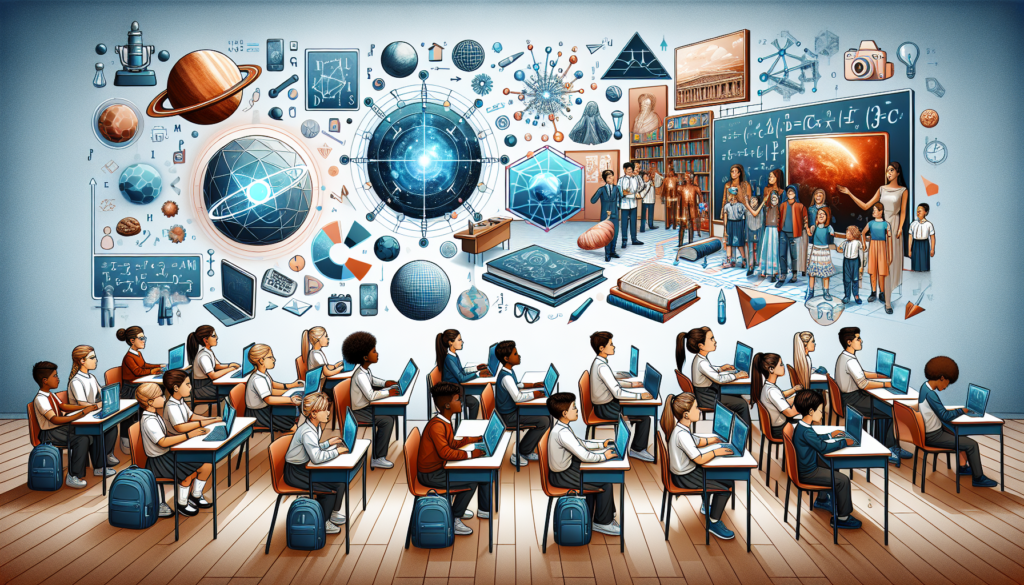markdown
At the confluence of technology and pedagogy, augmented reality (AR) emerges as a powerful tool that is reshaping education, taking interaction and immersion in content to previously unimagined heights. AR is a technology that superimposes digital information onto the real world, creating an interactive experience through various devices, such as smartphones, tablets, or specialized glasses. The implications of this synergy between the real and virtual open new frontiers for learning, enhancing information retention, student engagement, and providing a more personalized and self-directed teaching approach.
Practical Applications of AR in Education
Enriched Textbooks: AR adds an interactive dimension to standard textbooks, allowing students to visualize 3D models, animations, and simulations that enrich the printed material, facilitating the understanding of complex concepts.
Immersive Learning Environments: AR-powered virtual classrooms can take students on journeys through time and space, offering educational experiences that were impossible to replicate in a traditional classroom setting.
Detailed Simulations: Sectors such as medicine, biology, and engineering greatly benefit from AR's ability to simulate detailed procedures and phenomena, which is particularly valuable in technical and professional education.
Personalized Study Aids: AR can be tailored to individual learning needs and abilities, offering targeted help and adaptive study material to maximize educational effectiveness.
Impact on Knowledge Retention
Recent studies in cognitive psychology and education highlight that students retain information better when taught through multisensory experiences. This is particularly evident in contexts where augmented reality is employed to visualize abstract or inaccessible phenomena, facilitating deep understanding and long-term retention.
Recent Innovations
Geolocated Augmented Reality: Uses the user's location to provide relevant educational content. For example, applications that show historical information when visiting a specific site.
Image and Object Recognition: By pointing a camera at a real object, students can obtain detailed and contextual information about that element.
Intuitive User Interfaces: The integration of advances in ubiquitous computing allows students to interact with AR in a more natural and intuitive way, through gestures, voice commands, and eye tracking.
Current Challenges and Limitations
Despite its advantages, the widespread implementation of AR in the educational field faces technological and practical challenges:
Accessibility and Costs: Adopting AR requires compatible devices and up-to-date programs, which can entail a significant investment by educational institutions.
Development of Quality Content: The creation of comprehensive and diversified AR material demands time, specialized knowledge, and financial resources.
Teacher Training: Instructors must be adequately trained to integrate AR into their teaching methodologies.
Educational Equity Issues: The technological gap could widen if AR is not implemented equitably, leaving behind students from less privileged backgrounds.
Comparison with Preceding Educational Technologies
AR represents a qualitative leap compared to previous technologies such as virtual reality (VR), mainly because of its ability to integrate information into the real environment, improving the contextualization of learning and avoiding the isolation characteristic of VR.
Case Studies
Living History: A tangible example is the use of AR to transform the teaching of history, allowing students to participate in interactive historical reconstructions that provide a deeper understanding of past events.
3D Anatomy: AR has enabled the creation of detailed anatomical models with which medical students can interact, learning about human physiology in a more intuitive way.
Future Directions and Innovations
AR continues to evolve, merging with other emerging technologies such as artificial intelligence (AI) and machine learning (ML) to create adaptive and personalized learning systems. This advancement could lead to AR systems that analyze student performance in real time, adapting content to address knowledge gaps specifically and timely.
In addition, the design of brain-computer interfaces, which allow interacting with devices using brain signals, could further enhance the integration and naturality of AR experiences in education.
Conclusion
Augmented reality has the potential to radically transform the way we teach and learn. Despite the challenges, it is undeniable that AR will establish a new norm in education, offering richer, more interactive, and personalized learning experiences. To capitalize on its benefits, collaborative efforts among developers, educators, and policymakers are required, ensuring that this technology reaches its full potential while mitigating disparities and guaranteeing accessibility for all.

